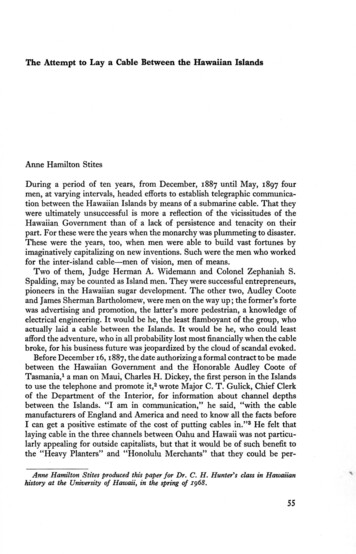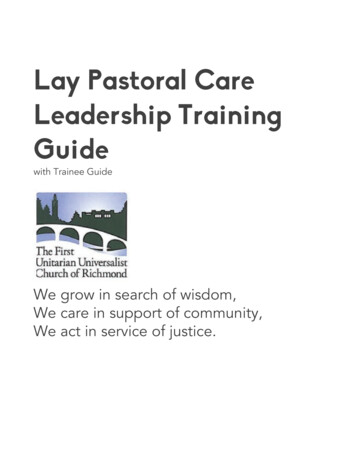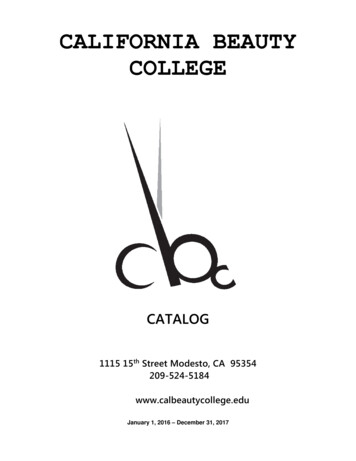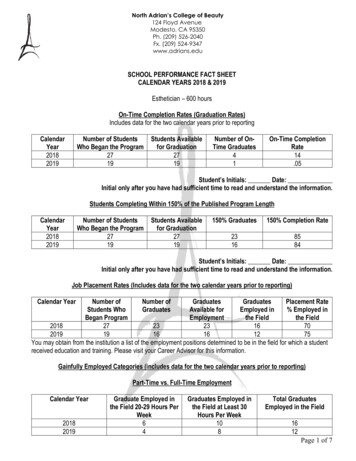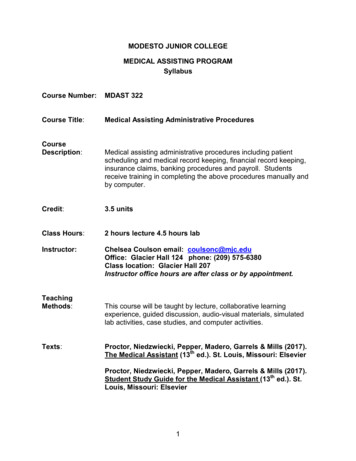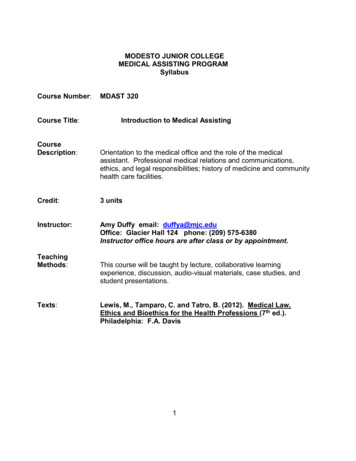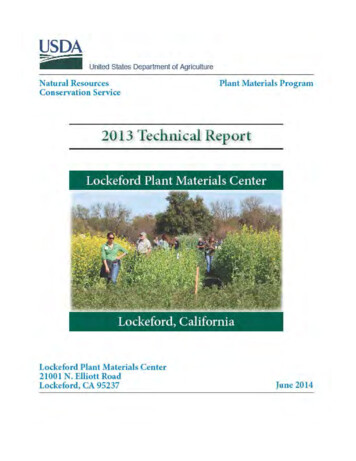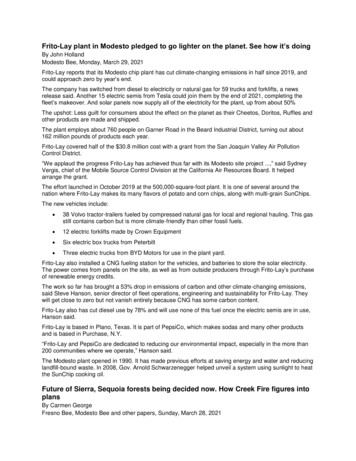
Transcription
Frito-Lay plant in Modesto pledged to go lighter on the planet. See how it’s doingBy John HollandModesto Bee, Monday, March 29, 2021Frito-Lay reports that its Modesto chip plant has cut climate-changing emissions in half since 2019, andcould approach zero by year’s end.The company has switched from diesel to electricity or natural gas for 59 trucks and forklifts, a newsrelease said. Another 15 electric semis from Tesla could join them by the end of 2021, completing thefleet’s makeover. And solar panels now supply all of the electricity for the plant, up from about 50%The upshot: Less guilt for consumers about the effect on the planet as their Cheetos, Doritos, Ruffles andother products are made and shipped.The plant employs about 760 people on Garner Road in the Beard Industrial District, turning out about162 million pounds of products each year.Frito-Lay covered half of the 30.8 million cost with a grant from the San Joaquin Valley Air PollutionControl District.“We applaud the progress Frito-Lay has achieved thus far with its Modesto site project .,” said SydneyVergis, chief of the Mobile Source Control Division at the California Air Resources Board. It helpedarrange the grant.The effort launched in October 2019 at the 500,000-square-foot plant. It is one of several around thenation where Frito-Lay makes its many flavors of potato and corn chips, along with multi-grain SunChips.The new vehicles include: 38 Volvo tractor-trailers fueled by compressed natural gas for local and regional hauling. This gasstill contains carbon but is more climate-friendly than other fossil fuels. 12 electric forklifts made by Crown Equipment Six electric box trucks from Peterbilt Three electric trucks from BYD Motors for use in the plant yard.Frito-Lay also installed a CNG fueling station for the vehicles, and batteries to store the solar electricity.The power comes from panels on the site, as well as from outside producers through Frito-Lay’s purchaseof renewable energy credits.The work so far has brought a 53% drop in emissions of carbon and other climate-changing emissions,said Steve Hanson, senior director of fleet operations, engineering and sustainability for Frito-Lay. Theywill get close to zero but not vanish entirely because CNG has some carbon content.Frito-Lay also has cut diesel use by 78% and will use none of this fuel once the electric semis are in use,Hanson said.Frito-Lay is based in Plano, Texas. It is part of PepsiCo, which makes sodas and many other productsand is based in Purchase, N.Y.“Frito-Lay and PepsiCo are dedicated to reducing our environmental impact, especially in the more than200 communities where we operate,” Hanson said.The Modesto plant opened in 1990. It has made previous efforts at saving energy and water and reducinglandfill-bound waste. In 2008, Gov. Arnold Schwarzenegger helped unveil a system using sunlight to heatthe SunChip cooking oil.Future of Sierra, Sequoia forests being decided now. How Creek Fire figures intoplansBy Carmen GeorgeFresno Bee, Modesto Bee and other papers, Sunday, March 28, 2021
New forest management plans that could be in effect for the next 15 years in California’s Sierra Nevadaare almost complete – using public comments made prior to the catastrophic Creek Fire that burnednearly a third of Sierra National Forest.The aftermath of that wildfire – the largest single fire in California’s history – isn’t prompting big changesin national forest plan revisions that have been in the works for years, federal land managers said.Officials said that’s because a previous draft released in 2019 already factored in the probability of futuremega wildfires.“The Creek Fire just validates what’s in there . it puts an exclamation point on the need to get this plan inplace,” said Sierra National Forest Supervisor Dean Gould.The final forest plans for Sierra and Sequoia national forests, and their shared environmental impactstatement, are expected to be released later this spring or summer. Key goals include reducingcatastrophic wildfires, improving ecosystem health and making recreational use sustainable.The popular forests sit between Yosemite National Park in the north and Sequoia & Kings CanyonNational Parks in the south.Forest plans set the “overall management direction and guidance for each national forest” and not sitespecific direction, “such as where to put a recreation trail or what timber will be harvested,” the draftenvironmental impact statement reads.U.S. Forest Service staff were still sifting through thousands of public comments received in late 2019about revised draft plans for Sierra and Sequoia when the Creek Fire and SQF Complex hit last summer.The largest was the Creek Fire (nearly 380,000 acres) in Sierra National Forest, more than double thesize of the SQF Complex (over 174,000 acres) which burned a portion of Sequoia National Forest. TheCreek Fire destroyed more than 850 structures, most of them homes.The plans are being looked at again because of those fires.When that’s done, there will only be an “objection phase” – different from the 90-day public commentperiod in 2019.Both national forests are operating under old forest plans finalized over 30 years ago. Sierra NationalForest’s plan was signed in 1991. Sequoia National Forest’s was signed in 1988. The regional foresterissued an amendment in 2004 in an effort to reduce the risk of catastrophic wildfires.National forests are asked to revise their plans within 15 years, making the final revisions expected thisyear long-awaited.Aside from air quality, these forests directly affect the lives of millions of people in California mostprominently via billions of gallons of water that annually flow from these forests into the central SanJoaquin Valley.WHAT WILL NEW SIERRA NATIONAL FOREST PLAN LOOK LIKE?Sierra National Forest’s 1.3 million acres extend from around 1,000 feet in elevation to nearly 14,000 feetand include 469 lakes – many of them popular recreation areas, like Bass Lake. The forest is visited bynearly 1.5 million people each year.Marc Meyer, a Southern Sierra ecologist based in Bishop with the Forest Service’s Pacific SouthwestRegion, is among those working on the forest plan revisions.People can expect increased work in three areas, Meyer said: “Mechanical thinning,” removing vegetation to reduce density within a stand of trees, includingremoving smaller trees. Prescribed burns, which are low-intensity fires lit and managed to reduce undergrowth. Managed wildfires for resource benefits, such as allowing a lightning fire to burn in the wilderness ifit’s not a significant threat to structures or air quality.
Supervisor Gould said specifics will depend on which alternative within the planning process is chosen,and that he’s able to combine aspects of different alternatives into one.Forest Service spokespeople highlighted Alternative B and Alternative B modified, which call for thetreatment of roughly 175,000 acres over 15 years. Officials said that’s roughly 28% of the forest in SierraNational Forest – about the same as what was in the 2019 revision – not counting acreage that’s notrelevant to vegetation treatments, such as granite rock, lakes and meadows.Meyer said the percentage is expected to stay about the same because there’s still such a “backlog” ofuntreated forests, even after the Creek Fire consumed thousands of acres.“Alternative B is the ‘preferred alternative’ and is reflected in the draft forest plans,” the forests’ shareddraft environmental impact statement reads. “It focuses on active management to restore healthierecosystems that are fire-adapted, clear direction for managing fisher and California spotted-owl habitat,the development of recreation management areas, and an aquatic and riparian habitat managementstrategy.”That alternative calls for reducing fire risks near communities by focusing on mechanical thinning andprescribed burning along roads and ridgetops, also in an effort to safely reintroduce fire.Nearly half of Sierra National Forest is designated wilderness, more remote areas that have moreprotections. Those include the Ansel Adams, John Muir, Kaiser, Dinkey Lakes and Monarchwildernesses.“These are not suitable for timber production, and vegetation management treatments for any purposewould be quite constrained,” a Forest Service spokesperson said about wilderness areas.“Practically speaking, designated wilderness or wild river segments would be very unlikely to receive anytreatments that involve cutting or harvesting of timber, or trees for any purpose. The most likely andcommon way for fuel treatments to occur in these areas would be for naturally-ignited wildland fires to bemanaged for benefits such as restoring the historic fire regime.”Sierra’s draft plan notes that only about 141,626 acres of the 1.3 million-acre forest are suitable for timberproduction, and of those acres not suitable, “timber harvest may occur to protect multiple use values otherthan timber production, and for salvage, sanitation, or public health.”Alternative B, the preferred alternative, limits the removal of conifer trees larger than 30 inches indiameter, with exceptions for “ecological restoration, safety, and equipment operability.”Conifers is the broad name for trees bearing cones with needle or scale-like leaves, typically evergreen,such as pine trees.Gov. Gavin Newsom’s Forest Management Task Force released a wildfire and forest resilience actionplan for California in January that also called for increased fuel treatments. Both the state, including CalFire, and the Forest Service aim to double annual fuel treatments by 2025. The report states that theForest Service will increase annual treatments across its California forests from 250,000 acres a year to500,000 acres by 2025.Fresno County Supervisor Nathan Magsig, whose district covers much of the area burned by the CreekFire, would like to see even more fuel treatments.Of Sierra National Forest’s plan now being revised, Magsig said it will only be “as good as giving certaintyto the timber industry, Cal Fire and communities that potentially lie in the path of a future wildfire.”In a February update about the forest plan revision process, the Forest Service announced, “Our workmoving forward is focused on updating the forest health, wildlife habitat and timber objectives of the plansand analysis. Minimal changes are expected to update our aquatics, watershed, and recreationmanagement approaches.”The forest plans being revised are somewhat broad like a guidebook, described as “an opportunity to seta collective vision for the future of this landscape.” Specific projects, such as cutting trees in a region,would still require separate proposals.
The 2019 revision describes it this way: “Forest plans emphasize strategic decisions about ‘why’ and‘what,’ and to a lesser extent, ‘when’ and ‘where.’ The ‘how’ decision is generally made at the tactical orproject planning level, and includes a set of site specific details of time, place and circumstances of aparticular project proposal.”Gould sees the new forest plan revision as a “cause for optimism” – a tool to increase work they’vealready accelerated in recent years.Going forward, Gould said there will be a “much stronger emphasis” on shared stewardship, includingwith nonprofit organizations, volunteer groups and commercial entities, “anyone that we can bring in tohelp us do the treatments that this plan will call for.”In the immediate future, he said his office plans to do more salvage work, finding uses for dead andburned wood.The Forest Service said about 44% of the nearly 380,000 acres consumed by the Creek Fire burned athigh severity (with high-severity fire burning between 24% and 64% of various forest types throughoutSierra National Forest).Conifers are expected to need a lot of help rebounding. The probability that these trees will naturally growback in Sierra National Forest is low (between 0 and 20%) or moderately low (between 20% and 40%) in54% of analyzed burned area, nearly 104,000 acres. The need for reforestation work is “very high” in atleast a quarter of that burn scar.In the timber section of the 2019 draft plan, a much smaller area for potential reforestation work is noted:Up to an average of 3,500 acres per year, where needed. An estimate isn’t given in the case of extremefire.Meyer said historically, patches of high-severity fire were relatively small, less than 10 acres, withanything above 100 to 200 acres “very rare.” That’s changed in recent years, with more and larger highseverity patches in California mega fires.There’s been a “complete loss of forest resilience” in some areas, Meyer said, where shrubs are nowtaking the place of trees. Meyer pointed to patches on the 2015 Rough Fire in Sierra National Forest, the2014 King Fire in El Dorado County and the 2013 Rim Fire in Stanislaus National Forest as examples.Barren hillsides devoid of trees can lead to other problems, like mudslides. The Fresno County Sheriff’sOffice has a map that shows mudslide risks.Fewer trees can also lead to water quality issues. Around 800 billion gallons of water annually flows fromSierra National Forest into the San Joaquin River in the north and the Kings River in the south. Theserivers provide drinking water and fill 11 reservoirs that help irrigate crops and provide hydroelectric powerfor the state. A portion of the Merced River, a tributary of the San Joaquin River, is also in Sierra NationalForest.OBJECTION PHASE COMING, SMALL CHANGES TO PLAN EXPECTEDThe Forest Service has been revisiting public comments submitted before the “uncharacteristically largeand destructive wildfires” of 2020 to make sure responses are taking changed conditions into account.There will be an objection phase when the final plan is released, where those who already submittedcomments are allowed to object if they feel what they proposed was not adequately addressed. TheForest Service said there’s no required amount of time for this phase.Most new information about changed conditions due to the Creek Fire is going into a supplemental reportto the environmental impact statement. Because the environmental impact statement itself isn’t beingchanged significantly, another round of public comments isn’t required, said Tasha Lo Porto, a regionalengagement planner with the Forest Service’s Pacific Southwest Region.“We’re not creating a new comment period because the information is substantially similar,” Lo Porto said.“There’s also more substantive changes being put in place, too,” Gould added, “just not close to themagnitude of the previous revision.”
Beyond the legality of it, Gould said another public comment period just isn’t needed. He acknowledgedthat some may be asking, “’How in the world could you have such a large fire and so impactful, and yetyour plan doesn’t change dramatically as a result of it?’ I can fully appreciate that perspective.”His answer: There was already a broad range of alternatives in the last revision that took large fires intoconsideration, informed by others in Sierra National Forest in recent years, including the Rough, Railroadand Ferguson fires.“The plan really was pretty predictive in being able to treat the landscape as if large fires would continueto occur,” Gould said.Supervisor Magsig said he’s OK with the Forest Service not doing another public comment period thisyear.“I don’t see how those comments will change a whole lot,” Magsig said, “and at some point with any plan,you have to just release that and make tweaks going forward.”Magsig said most constituents who talk to him about Sierra National Forest talk about wanting moreaccess to it, including more mountain biking and walking trails.Gould said there has been a “dramatically increased interest in recreation” in Sierra National Forest inrecent years.“Last summer, from the beginning of the season on, it was almost like every weekend was Fourth of Julyon the forest,” Gould said, “and we’re expecting that to continue.”Sierra National Forest has at least 1,300 miles of trails and 2,000 miles of rough graded roads in additionto nearly 400 miles that passenger cars can easily access. About 20 miles of the iconic Pacific Crest Trailpasses through the forest.THE PLANNING PROCESSLo Porto said the new plan expected this year will allow land managers to more easily do beneficial work,instead of having to file “forest plan amendments for each project, or bend over backwards to satisfy theold plan.”The Creek Fire ignited in an area that had been approved for a fuel treatment project just a couplemonths prior.A 2012 Forest Service planning rule provided the framework for this latest revision. The process startednine years ago with an assessment phase in 2013, followed by a proposed action in 2014. Draft forestplans and the environmental impact statement were released in 2016.Inyo National Forest was working on this process with Sierra and Sequoia, but ended up forging aheadon its own because it didn’t have the same tree mortality issues that hit the western slopes of the SierraNevada. Inyo’s plan was finalized in 2019.Sierra and Sequoia instead revised their plans again, factoring in thousands of newly-dead trees frombark beetles, drought and climate change, and released another revision in 2019. The last publiccomment period followed that fall.There were 7,340 public comments received during that comment period, 634 of which were considered“unique submissions,” which means the comments are not identical to other submissions, such as formletters from organizations.The Forest Service said there were two other formal public comment periods throughout this process: a30-day window in 2014, and a 90-day comment period in 2016.BALANCING INTERESTS, INCLUDING PROTECTING ENDANGERED SPECIESFederal land managers are tasked with doing vegetation treatments in tandem with ensuring the survivalof thousands of species that call the forest home. Striking that balance can be difficult and lawsuits havearisen, like one filed last year to further protect the California spotted owl.
The Southern Sierra population of fisher, an elusive animal that resembles a weasel, was listed asfederally endangered in June.Gould said he doesn’t see reducing fuel in the forest and protecting wildlife as being in a “tug of war” witheach other.“I tend to look at them as all part of the same picture, rather than this or that,” Gould said. “The fisher andother endangered species, they have a place on the forest, and vegetation treatments. They all need tobe in balance and in compliment to each other and not in detriment to each other.”Sierra National Forest is home to about 350 species of animals and over 1,400 plant species. Of those, atleast 45 species of plants and 20 species of mammals, birds, amphibians, fish and invertebrates werelisted by the regional forester in 2016 as species of conservation concern. That means there are concernsabout that species’ ability to exist on a landscape for a long time.Of Sequoia National Forest’s more than 300 species of animals and over 2,000 plant species, 30 speciesof animals and 45 species of plants were listed as species of conservation concern.In a Bee story about a burned fisher fleeing the Creek Fire, Craig Thompson, an ecologist and ForestService wildlife biologist, said the Endangered Species Act, in its best application, can help all – animals,landscapes and people.“In some ways, the listing can make it harder because there are more hoops to jump through if you wantto do vegetation management in fisher habitat,” Thompson said. “On the other hand, it also recognizesthe fact that management is even somewhat more important to protect what we have.”Teresa Benson, supervisor of Sequoia National Forest, talked about using science to ensure fueltreatments like prescribed burning aren’t done during the prime of a threatened species’ breeding time –one example of trying to manage fuels in a way that could be less harmful to wildlife
Mar 29, 2021 · Frito-Lay plant in Modesto pledged to go lighter on the planet.See how it’s doing By John Holland Modesto Bee, Monday, March 29, 2021 Frito-Lay reports that its Modesto chip plant h



